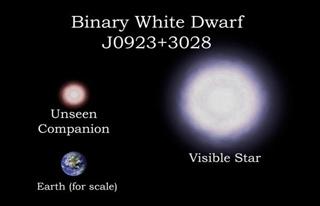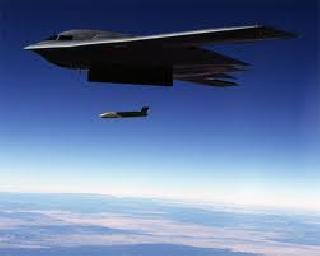
The binary star system J0923+3028 consists of two white dwarfs: a visible star weighing 23 percent as much as our Sun and about four times the diameter of Earth, and an unseen companion weighing 44 percent of the Sun and about one Earth-diameter in size. Photo: Clayton Ellis (CfA).
CAMBRIDGE, MASSACHUSETTS (BNS): Astronomers have discovered a dozen previously unknown double-star systems, each on a course to end in spectacular explosions detonated by the crash between their two small, dense stars.
All of the newfound binary stars consist of two white dwarfs. A white dwarf is the hot, dead core left over when a sun-like star gently puffs off its outer layers as it dies. A white dwarf is incredibly dense, packing as much as a sun's worth of material into a sphere the size of Earth. A teaspoon of it would weigh more than a tonne.
"These are weird systems - objects the size of the Earth orbiting each other at a distance less than the radius of the Sun," Smithsonian astronomer Warren Brown, lead author of the two papers reporting the find, was quoted as saying in a news release by Harvard-Smithsonian Center for Astrophysics.
The white dwarfs found in this survey are lightweight among white dwarfs, holding only about one-fifth as much mass as the Sun. They are made almost entirely of helium, unlike normal white dwarfs made of carbon and oxygen, the report added.
"These white dwarfs have gone through a dramatic weight loss programme. These stars are in such close orbits that tidal forces, like those swaying the oceans on Earth, led to huge mass losses," said Carlos Allende Prieto, an astronomer at the Instituto de Astrofisica de Canarias in Spain and a co-author of the study.
These white dwarfs turn around so close to each other, that they stir the space-time continuum, thus creating gravitational waves.
The waves carry away orbital energy, the stars keep spiraling closer together and eventually, half of these systems should merge.
The researchers calculated that the tightest 'duo', which orbits once every hour, will merge in about 100 million years.
"We have tripled the number of known, merging white-dwarf systems. Now, we can begin to understand how these systems form and what they may become in the near future," said Smithsonian astronomer and co-author Mukremin Kilic.
When two white dwarfs merge, their combined mass can exceed a tipping point, causing them to detonate and explode as a Type Ia supernova.
Brown and his colleagues suggest that the merging binaries they have discovered might be one source of underluminous supernovae -- a rare type of supernova explosion 100 times fainter than a normal Type Ia supernova, which ejects only one-fifth as much matter.
Brown also explained that, the rate at which our white dwarfs are merging is the same as the rate of underluminous supernovae - about one every 2,000 years.
"While we can't know for sure whether our merging white dwarfs will explode as underluminous supernovae, the fact that the rates are the same is highly suggestive," he concluded.
 Previous Article
Previous Article Next Article
Next Article













The Indian Air Force, in its flight trials evaluation report submitted before the Defence Ministry l..
view articleAn insight into the Medium Multi-Role Combat Aircraft competition...
view articleSky enthusiasts can now spot the International Space Station (ISS) commanded by Indian-American astr..
view article